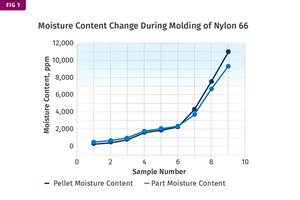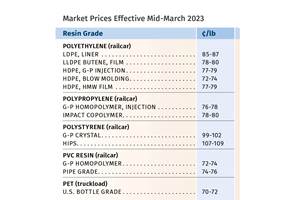Automotive Awards Highlight ‘Firsts,’ Emerging Technologies
Annual SPE event recognizes sustainability as a major theme.
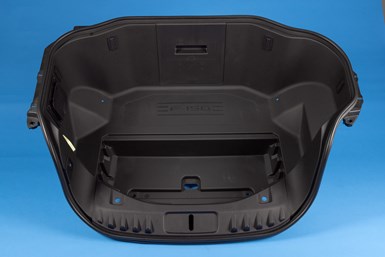
The 2024 Ford F-150 Lighting’s injection-molded LFT-PP frunk was the grand winner of the 52nd SPE Automotive’s Innovation Awards. Photo Credit: SPE Automotive Division
The 52nd annual Society of Plastics Engineers (SPE) Automotive Division’s Blue Ribbon Automotive Innovation Awards once again celebrated several “firsts” among eight categories, which included innovations in last year’s added categories of Electric & Autonomous Vehicle Systems and Aftermarket & Limited Edition/Specialty Vehicles, as well as an expanded and renamed Sustainability category. As has been the case for the last several years, thermoplastics and thermoplastic composites led by far in all categories.
Since 1970, this globally oldest and largest competition of its kind has highlighted the positive changes that polymeric materials have brought to automotive and ground transportation industries, such as weight and cost reduction, parts consolidation, increased safety, and enhanced aesthetics and design freedom.
Dozens of teams made up of OEMs, tier suppliers and polymer producers submit nominations describing their part, system or complete vehicle and why it merits the claim as the ‘year’s most innovative use of plastics.’ The annual event typically draws approximately 700 OEM engineers, automotive and plastics industry executives, and media.
Here is a look at this year’s winners, starting with the grand award and category winner, body interior:
Body Interior: Mega Bin/Frunk
The grand award winner which appears in the battery-electric Ford Motor’s 2024 F-150 Lightning is a first in that it entailed converting from compression-molded painted SMC to mold-in-color, injection-molded PP-LFT (40% glass) to produce the industry’s largest Class A composite frunk.
Produced with Celanese’s Celstran PP-GF40 by Cascade Engineering, this conversion resulted in a 48% mass reduction and a 37% cycle time reduction, while eliminating the cost and environmental burden of paint. Also, seal interfaces were improved, secondary routering of holes is no longer needed and the frunk is fully recyclable at end of life. A 4,000-ton injection press and a tool equipped with a 16-drop hot runner system are used to mold parts.
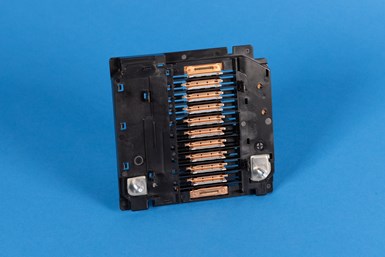
The 2024 GM Chevy Corvette E-Ray won the Aftermarket & Limited Edition/Specialty Vehicles Award for its hybrid battery interconnect board. Photo Credit: SPE Automotive Division
Aftermarket and Limited Edition/Specialty Vehicles: Hybrid Battery Interconnect Board
Another first is a patented hybrid battery interconnect board that appears in General Motors’ Chevrolet Corvette E-Ray. Produced by Sun Microstamping Technologies using BASF’s Ultramid B3UG4 nylon 6, it features small and delicate metal current collectors, bus bars and sensing lines in a very compact design to fit in limited packaging space.
The 20% GF/PA6 grade, which is also heat stabilized and flame retardant, was selected for its ability to offer high levels of functional integration in limited space plus be compatible with snapfits, heat staking, ultrasonic welding and adhesive bonding. Laminated core-block inserts are used in rotary injection tooling for venting and to control stampings during overmolding.
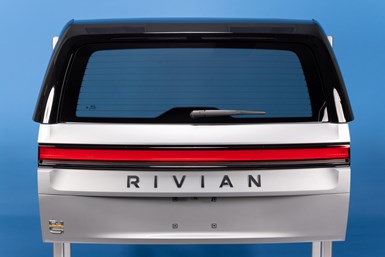
The 2023 Rivian R1S won the 2023 SPE Automotive Innovations Award for its thermoplastics splitgate. Photo Credit: SPE Automotive Division
Body Exterior: Thermoplastic Splitgate
Said to be the world’s first all-thermoplastic splitgate rear closure system, which is delivered to the assembly line as a ready-to-install module, it is featured in Rivian’s 2023 Rivian R1S all-electic SUV.
Injection molded by Magna International with Advanced Composites’ 40% glass-reinforced LGF-PP and TPO, it features a complex, deep draw (>80 mm) design, which is said to offer improved perceived quality at lower mass, NVH, and cost vs. metals, and is offered in a two-tone execution. By commonizing grades between the liftgate and the benchgate and focusing on sustainability, parts were reduced from nine to three and with just two materials — a 40% glass-reinforced LFT-PP and a TPO. The CHMSL (center high-mounted stop lamp) and taillamps were carried over from Rivian’s pickup model.
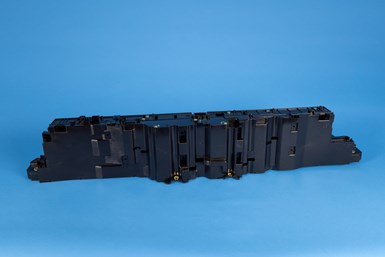
The GMC Hummer EV received the 2023 SPE Automotive award for the electric and autonomous vehicle systems category.
Photo Credit: SPE Automotive Div.
Electric & Autonomous Vehicle Systems: Battery Disconnect Unit
A metal-to-plastic innovation, which appears in General Motors’ electric GMC Hummer EV, is the two BDUs (battery disconnect units) which have been integrated into a single system supporting two 400-volt systems. It is injection molded by Lear Corp. using BASF’s 25% glass-reinforced nylon 66 Ultramid 66 H2 G25 V0KB1 and hydrolytically-resistant PBT Ultradur B4450G5 HR.
This integrated system is said to enable fast and safe recharging of EVs, and disconnects power in an overcurrent situation to protect passengers. The meter-long parts feature a complex design that offers improved thermal management and reduced component mass. The two UL94 V0 halogen-free materials — one, the PBT, with very-high CTI (comparative tracking index, which measures the electrical breakdown of an insulating material) replaced die-cast aluminum while maintaining superior physical properties and ease of processing. Complex simulation and process optimization were also key to success.
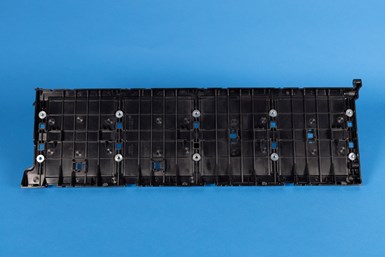
GM’s 2024 Chevrolet Corvette E-Ray won the 2023 SPE Automotive’s Innovation Award in the materials category.
Photo Credit: SPE Automotive Division
Materials: Battery Module Side Plates
Yet, another metal-to-plastic innovation is the patented battery module side plate in General Motors’ 2024 electric Chevrolet Corvette E-Ray. Injection molded by the Novares Group using RTP Co.’s RTP-299 K X 138337 black PARA (polyarylamide) material, it results in extremely flat side plates for this battery module. The parts boast high dimensional accuracy, stiffness and strength in a complex geometry.
The high-modulus, creep-resistant, flame-retardant polymer eliminated the need for compression limiters and electrical isolation films, yet withstands extreme pressures from cell expansion and met all mechanical requirements. In addition, four components were reduced to one and many functional features were incorporated in the patented side plates that would not have been possible in metals. Mass was reduced by 37% and cost by 55%.
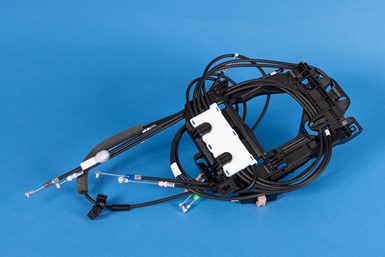
Toyota’s 2024 Grand Highlander’s seat module received SPE Automotive’s 2023 Innovation Award for the process/assembly/enabling technologies category. Photo Credit: SPE Automotive Division
Process/Assembly/Enabling Technologies: Seat Module
This patented injection-molded seat module in Toyota Motor’s 2024 Toyota Grand Highlander hybrid SUV incorporates both temporary and permanent holding features to control cables and dramatically reduce both components and labor at the seat manufacturer.
The seat cables produced by Tier 2 supplier Hi-Lex Controls are delivered to Tier 1 supplier Toyota Boshoku pre-routed on the module plate and injection molded with Washington Penn’s 40% glass-reinforced PP. This eliminates the brackets, cable ties and clips typically used to control seat cables, and greatly reduces labor for an assembly operator. The module also reduces rework and scrap due to cable misalignments. In addition, lever pull effort for consumers is reduced because direct cable routing enables use of shorter cables.
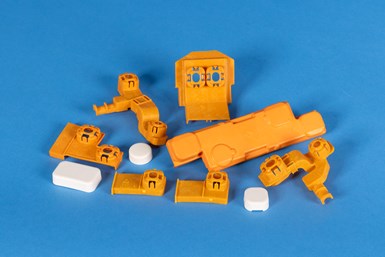
The Safety category award for the 2023 SPE Automotive Innovation Awards went to GMC’s Cadillac Lyriq and Hummer for its intumescent terminal covers. Photo Credit: SPE Automotive Div.
Safety: Intumescent Terminal Covers
Said to be the first ever use of a flame-retardant intumescent flexible PVC as an insulator for thermal runaway mitigation in high-voltage batteries for electrical vehicles, this terminal cover appears in General Motors’ 2023 Cadillac Lyriq and GMC Hummer. Injection molded by Molded Precision Components (MPC) for Tier 1 Auto-Kabel (AK) using Pyrophobic Systems’ Lithium Prevent 200 PVC, it replaces ‘traditional’ plastics (PP/PE/nylon) which melt and burn in thermal runaway conditions.
This specially-formulated, high-temperature, high-voltage PVC insulator is used to injection mold various terminal caps and barriers. Safety is increased during thermal runaway because the material maintains high dielectric strength, reducing arcing risk and ignition of gases, and forms a structured char barrier, helping reduce spread of fire from one module to another.
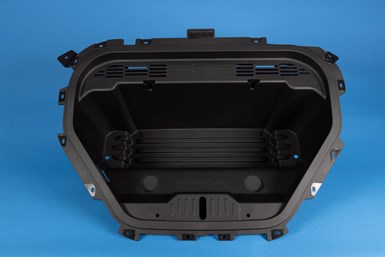
The 2024 Ford Mustang Mach E trunk with a PCR-content TPO won the 2023 SPE Automotive Innovation Award for sustainability. Photo Credit: SPE Automotive Div.
Sustainability: One-Piece Frunk
Yet another industry first is a 20% postconsumer-recycle (PCR) content, mold-in-color, Class A structural frunk for Ford Motor’s 2024 Ford Mustang Mach E. It is injection molded by IAC Group using Advanced Composites’ ADX-8327 Recycled Grade TPO, which will also be used in the 2025 model year vehicle. PCR content is sourced from yogurt cups and packaging materials.
Versus virgin TPO, the more sustainable grade lowered density slightly and offered better impact at 5°F (-15°C). Concurrent redesign reduced component count from six to one, including eliminating two metal brackets, saving 6.6 lbs of mass, increasing cargo volume and functionality, improving water management, reducing labor and reducing greenhouse emissions by 67%. Cost savings of $26.26 per vehicle are achieved.
Related Content
What's the Allowable Moisture Content in Nylons? It Depends: Part 2
Operating within guidelines from material suppliers can produce levels of polymer degradation. Get around it with better control over either the temperature of the melt or the barrel residence time.
Read MoreGeneral Polymers Thermoplastics to Further Expand Distribution Business
NPE2024: Following the company’s recent partnership buyout, new North American geographic territories are in its sight.
Read MorePrices of Volume Resins Generally Flat or Lower
Exceptions in early March were PP and PS, which moved up solely due to feedstock constraints, along with slight upward movement in PVC and PET.
Read MoreScaling Up Sustainable Solutions for Fiber Reinforced Composite Materials
Oak Ridge National Laboratory's Sustainable Manufacturing Technologies Group helps industrial partners tackle the sustainability challenges presented by fiber-reinforced composite materials.
Read MoreRead Next
Lead the Conversation, Change the Conversation
Coverage of single-use plastics can be both misleading and demoralizing. Here are 10 tips for changing the perception of the plastics industry at your company and in your community.
Read MoreSee Recyclers Close the Loop on Trade Show Production Scrap at NPE2024
A collaboration between show organizer PLASTICS, recycler CPR and size reduction experts WEIMA and Conair recovered and recycled all production scrap at NPE2024.
Read More














